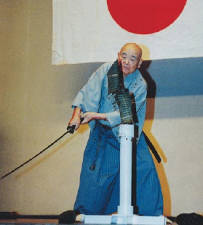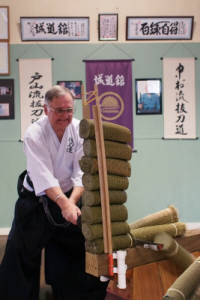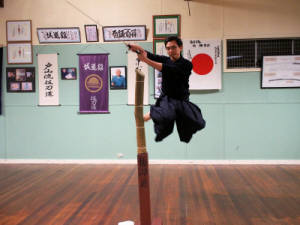
Throughout history the sword has conquered many nations, and its importance as a weapon and symbol of power still remains with us well into the 21st century.
When the first classic amour (yoroi) appeared in 1000 A.D., incorporating the Asiatic style of lamellar amour, the sword (katana) had finally found its match.
Sword smiths had a hard time keeping a step ahead of amour smiths, and it was during the Kamakura Era (1192-1333) that sword smiths like Masamune, Muramasa and Sadamune became legends in their own right, creating blades of extreme sharpness, power and beauty.
Having a newly forged blade test cut (tameshigiri) could give the sword smith valuable information on how to improve the quality of his blades, as the test would reveal weaknesses in the blades shape, construction and forging techniques.
A successful test cut would not only increase the value of a blade, but would spread the maker's fame and prestige throughout the country, making him rich and influential. The best documented test cuts on helmets, sword guards, wrought iron, old iron and other hard materials like antlers, comes from the Edo Period (1603-1867) and shows us the methodical application used in tameshigiri.
The term tameshigiri has survived to this very day and is still been used by sword practitioners to demonstrate their cutting kills on rolled up matting and green bamboo targets.
In Battodo tameshigiri is performed on single and multiple targets with wide circular blade movements, utilizing the power of the abdomen hara and hip. In Battodo targets are only cut once, replicating the "one cut – one kill" sword cutting method of the Samurai warrior on the battle field. During practice howhever, a target is cut many times as tatami are an expensive comodity.
Not only does tameshigiri teach the correct attack and cutting angle of the blade, it also places much emphasis on sword control; especially after the completion of a cut (tome). This involves correct sword grip, proper stances, precise footwork and body posture. Overbalancing after a cut is a common problem and so are the use of the shoulders as a power source and moving the left hand off the body-centre line.
Competition tameshigiri concerns itself mainly with the judging of cutting targets (tatami-omote) on a vertical stand. The multiple cutting of one or more targets is very popular as it requires a keen eye for distance, balance and excellent sword control.
Thus, Nakamura Ryu Battodo combines practical and realistic sword training, single sword forms, partner exercises and test cutting into a no-nonsense sword art promoting mental awareness and spiritual growth.
Tameshigiri
,
the art of test cutting with a Japanese sword consists primarily of cutting targets made up of rolled-up and dampened Japanese floor mats (tatami-omote) and/or green bamboo.
Tameshigiri is an essential part of Nakamura Ryu Battodo and a first rate indicator of a swordsman's true sword handling ability.
© 2009 - SSJS, Sei Do Kan All rights reserved.
Tameshigiri by Nakamura sensei at age 88!
Source: The Hiden Budo & Bujutsu magazine

At age 78 Hans Fricke; a former personal student of Nakamura sensei, cutting 8 tatami-omote with suemono-giri
Ben Chow, student of Fricke sensei, performing an extraordinary jumping kiriage at the Sei Do Kan dojo, Sydney 2014.
Well executed kesa-gir by student Calvin Chiu.2015



